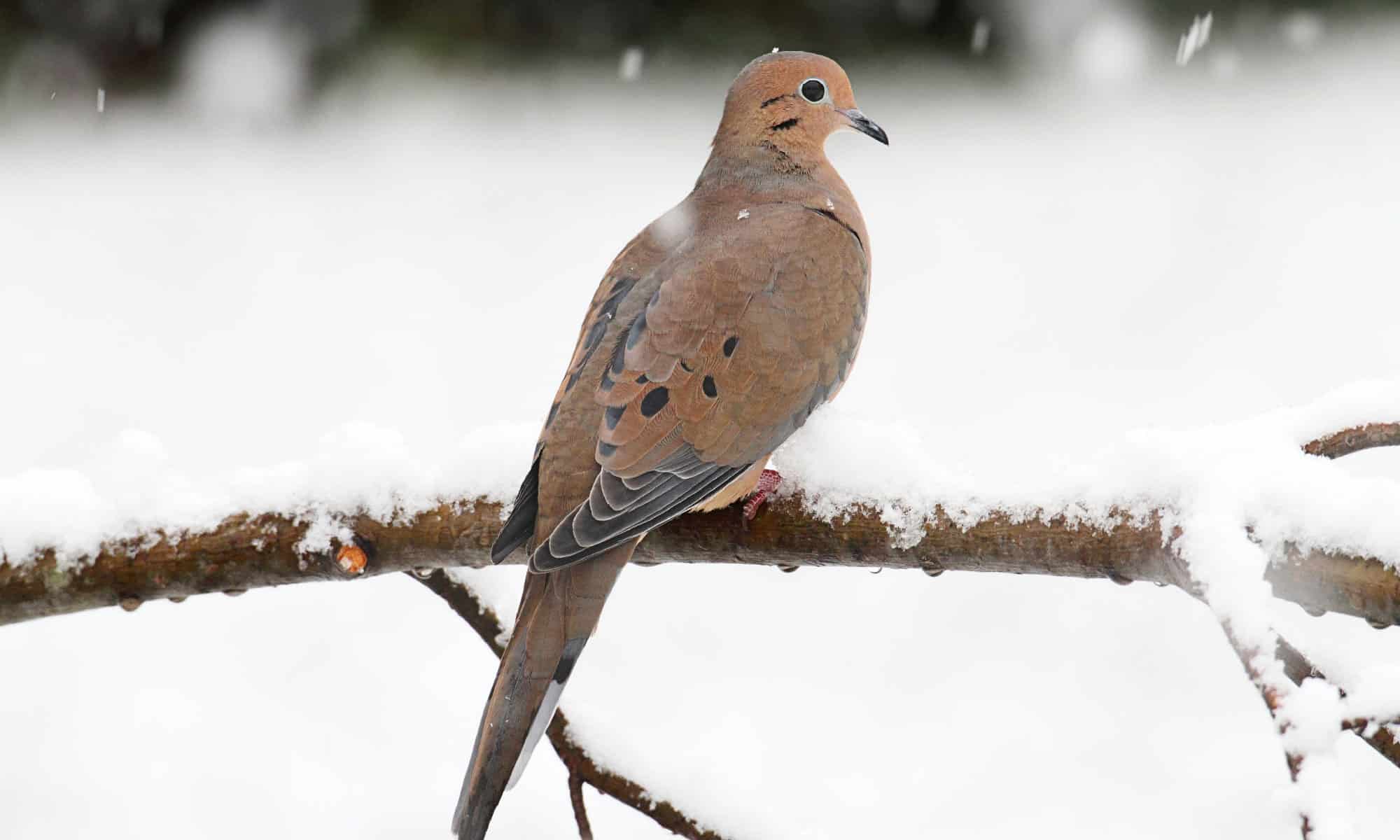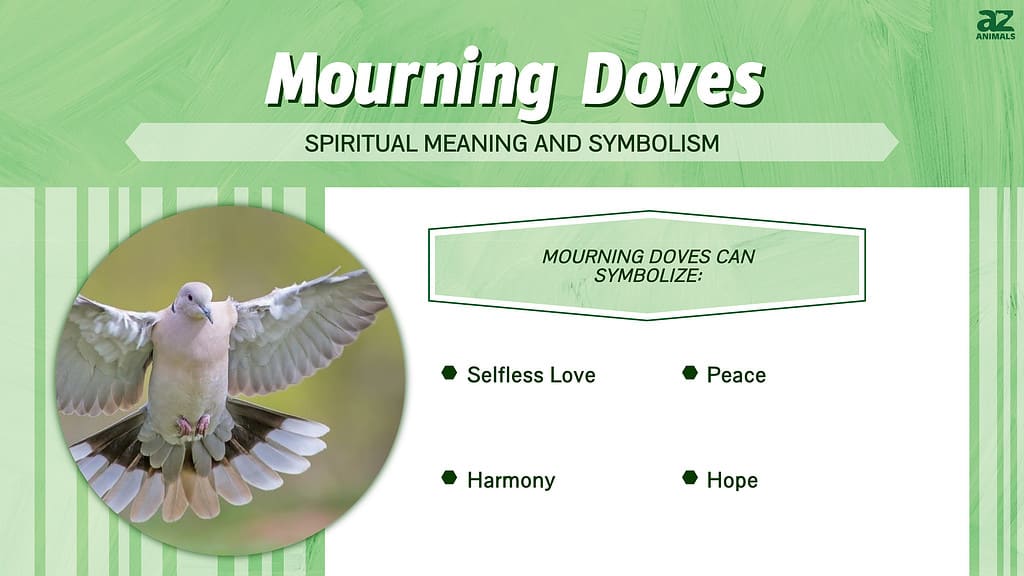
Have you ever been outside on a quiet morning and heard a song that seemed to carry a hint of sadness? Perhaps it was the heartfelt call of mourning doves. Their sad tune gives them their name—”mourning” doves. The call, mainly produced by males, helps them attract lifelong mates. Unlike many other birds that engage in yearly courtship, mourning doves are mostly monogamous. They have a special courtship ritual and are very picky when choosing a mate. Once they find a partner, they commit to them for life.
Because of their appearance, sounds, and exceptional parenting behaviors, these doves have become stars in stories and tales from different cultures. They’ve also got special meanings depending on where you are. Follow along as we unveil more about the meaning and symbolism of mourning doves.
Mourning Dove Overview
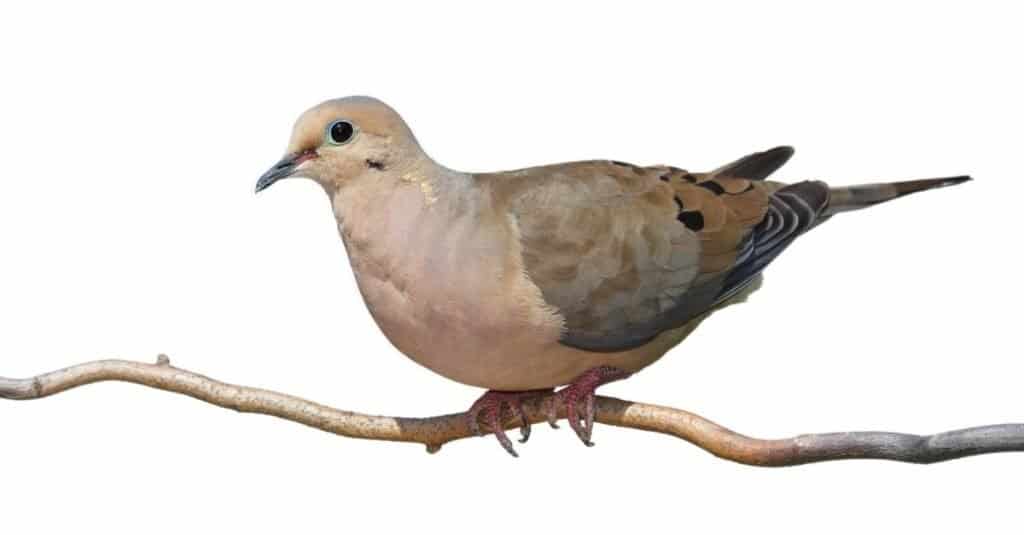
Considered a medium-sized bird, morning doves are only about 9 to 13 inches long.
©Mike Truchon/Shutterstock.com
Mourning doves are medium-sized birds about 9 to 13 inches long, with a wingspan of 15 to 18 inches. They have grayish-brown bodies, long tapered tails with white edges, small heads, and thin black bills. Their legs and feet are small and pink, and you can spot black markings on their wings and under their eyes. A blue circle of skin surrounds their brown eyes. Mourning doves are a common sight across the continent.
Males and females look similar, but females are a bit smaller and less colorful. Male mourning doves have patches of bright, iridescent purple-pink on the sides of their necks, along with light pink coloring down to their breasts. Their crowns are bluish-grey, and they have wide wings with black spots. On the other hand, female mourning doves are more brown overall, smaller in size, and lack the bright feather patches found in males.
Interestingly, mourning doves are related to other doves and pigeons like the eared dove and Socorro dove. They’re even more distantly related to the wild or passenger pigeon. There are also subspecies of mourning doves with slight differences, including variations in coloring, beak size, and leg length.
History
A long time ago, when people first came to North America from Europe, these doves were found in just a few scattered areas. As people started changing the land, like cutting down trees and making fields, it turned out that mourning doves liked these changes. They found these new landscapes to be just right for them, and their numbers started to grow.
Today, mourning doves are the only native North American birds that build their nests and raise their chicks in all 50 states, even in places like Hawaii. They have quite an extensive range, stretching from the southern parts of Canada down to central Mexico. One of the reasons they’re so successful is because they’re good at adapting. They’re experts at living in places that have been changed by humans. They do well in places that are not completely wild but not super crowded either—places like open fields, parks, and neighborhoods.
Mourning Doves Symbolize Selfless Love
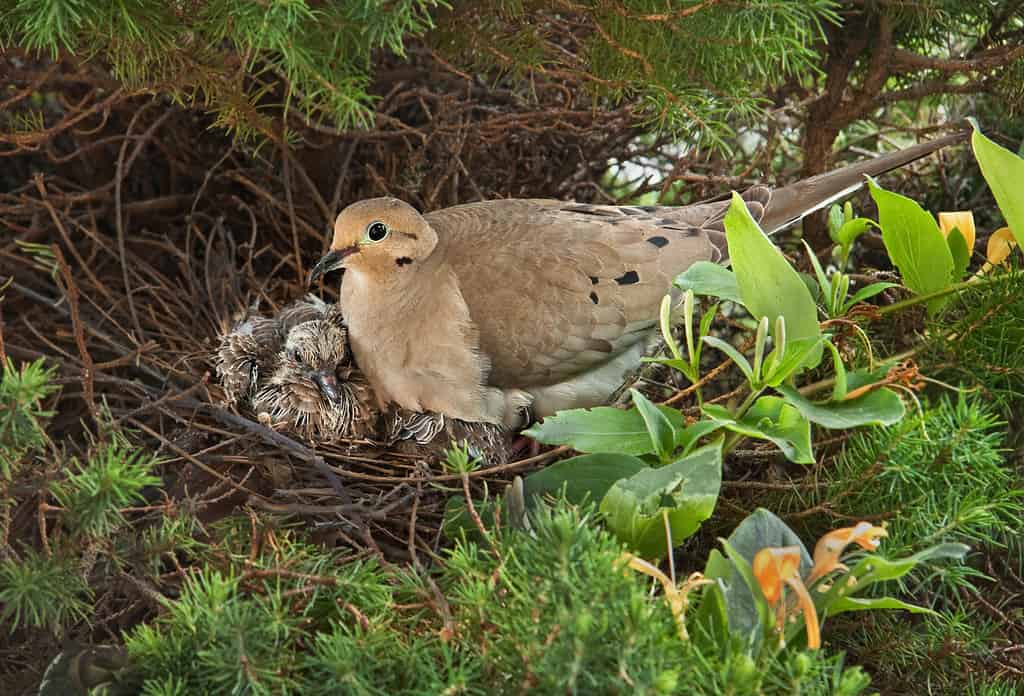
Mourning doves are great parents, with both males and females working together to raise their young.
©YegoroV/Shutterstock.com
Mourning doves are true symbols of selfless love due to their remarkable parenting behavior. Both mom and dad doves work together to raise their young, showing a remarkable sense of dedication. For about two weeks, these dove parents take turns keeping their eggs warm during incubation. Once the eggs crack open, it’s an all-hands-on-deck situation as both parents feed their squabs (that’s what baby doves are called) with a special “pigeon milk” they create in their throats.
In certain places, a pair of doves can take care of 5-6 groups of baby doves or broods in just one year. But usually, they take care of 2-3 broods. Sometimes, they even use the same nests for up to five rounds of eggs during the same year. Their nesting time, from March to October, works for the different weather in different areas. In warmer places, mourning doves begin laying eggs as early as March, but in colder areas, this might start in April or May.
Mourning Doves and Funerals

During times of loss, mourning doves serve as a reminder that all is well, and life will go on.
©Tuomas Kallio/Shutterstock.com
In a time of sadness, doves encourage us to remember that new beginnings and hope are always possible. Doves are well-known symbols of peace, love, and harmony. Their message focuses on finding harmony with what is, even when we don’t understand it. The sighting is intended to leave you with a sense of peace and well-being. Sometimes this peaceful message centers around the passing of life. For this reason, seeing a mourning dove is often seen as a sign of departed loved ones being present.
What does it mean when a mourning dove coos? The cooing can represent new beginnings, either after tough times or even after someone passes away. These doves remind us to keep hope alive and view death as a fresh start. They bring a sense of harmony during grief and can help with the process of healing.
Is a Mourning Dove Good Luck?
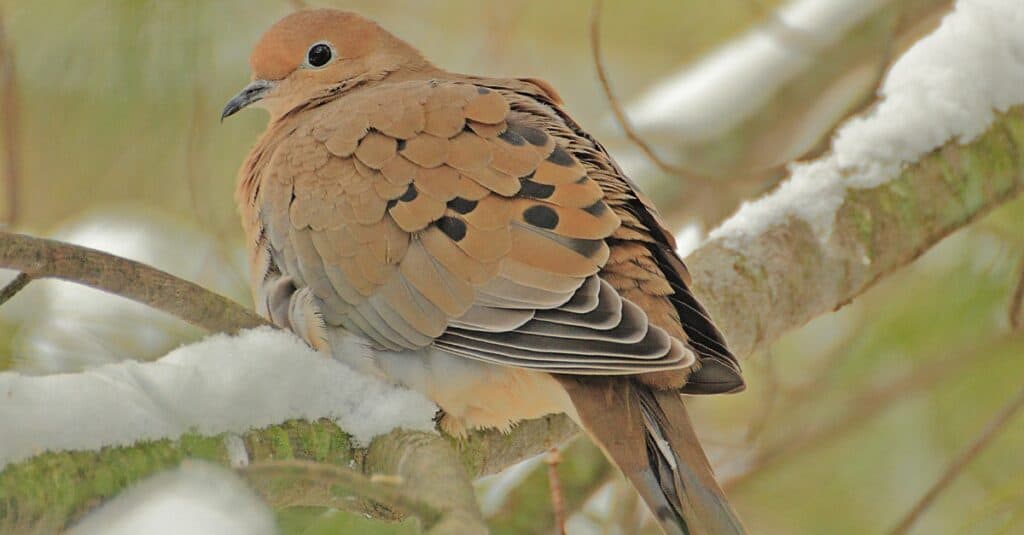
Seeing a mourning dove is a sign of good fortune and fresh beginnings.
©iStock.com/gregvandeleest
Mourning doves are seen as lucky, bringing peace and harmony. Spotting one is a positive sign. For some, it signifies new starts and fresh beginnings. Others find comfort in these elegant birds, as they remind us of cherished memories of those we’ve lost. Mourning doves serve as a reminder that through our thoughts and memories, the presence of loved ones lives on.
Sometimes the mourning dove is often seen as a symbol of sadness and loss. But this bird also carries messages of limitless love. When you see one, it can remind you that others understand your pain. Take a page from the mourning dove’s gentle nature, practicing self-love and patience even during tough times.
Mourning Dove Sounds and Their Meanings
In medieval Europe, the first call of a dove in a year was thought to bring luck or bad luck. If a dove cooed from a high place, it meant good luck and success. But if the call came from a low or below place, people believed that something bad was on the way.
Perch Coo
Hearing a mourning dove coo can be a reminder to stay faithful to what you believe in. The perch coo starts before sunrise and can last for hours, continuing later in the morning and afternoon. It’s a series of coos with a higher-pitched coo in the middle and a lower-pitched ones at the end. Male doves use this call to attract mates during breeding. And since mourning doves are a mostly monogamous bird species, they usually stay with their partner for life.
Nest Call
The nest call is comprised of three quick coo-oo-oo notes. Hearing this sound can be a reminder to support your team. The nest call is a lot like the perch coo but softer and with different tones. This call is used to attract females to potential nesting spots. It can also signal that parents should swap when sitting on eggs.
Wing Whistle
Is there something you need to prepare for? Hearing a mourning dove’s wing whistle can be a reminder or “alarm” letting you know it’s time to start preparing. When doves take off or flap their wings, they make a loud, whistling sound known as a wing whistle. This serves as an alarm to warn other doves about nearby predators. At birdfeeders, this whistle means immediate danger, prompting other doves to leave.
Cultural Significance

Mourning doves have wildly different meanings across Native American tribes.
©CHOTE BKK/Shutterstock.com
Protection, foolishness, spirituality; mourning doves have wildly different cultural meanings from one culture to the next. For instance, doves have always held special meanings and roles in the myths and stories of Native American tribes. Different tribes saw doves in unique ways, and these beliefs reflected the qualities they associated with these birds. Among the Blackfoot tribe, doves were thought to bring protection and ensure the safe return of warriors from battle. War leaders used dove feathers as talismans to make sure their warriors came home safely.
In some California Indian tribes, doves were linked to ideas of foolishness and naivety. While, the Cherokee tribe connected these doves with acorns, and the dove’s cooing sound even resembled the Cherokee word for “acorn.” Finally, among the Eastern Algonquian tribes, mourning doves were believed to have connections to the spirit world. At certain times, their cries were seen as signs of impending death.
Xochiquetzal: Aztec Goddess
The Aztecs and Mexican Indian tribes held doves as symbols of love. The goddess Xochiquetzal, who represented love, art, dance, and music, was often symbolized by a dove. Xochiquetzal’s name comes from the Nahuatl language. It combines “Quetzalli,” referring to a bird with magnificent feathers, and “Xóchitl,” which means flowers. This combination reflects the beauty and splendor associated with both birds and flowers, embodying the essence of Xochiquetzal. Xochiquetzal, residing above the Nine Heavens, was believed to reward the faithful with eternal paradise. The dove was even said to grant unique voices and languages to the children of Xochiquetzal. Doves, in this way, stood as a connection between the spiritual and physical realms, connecting both worlds.
More Symbolisms Across Cultures
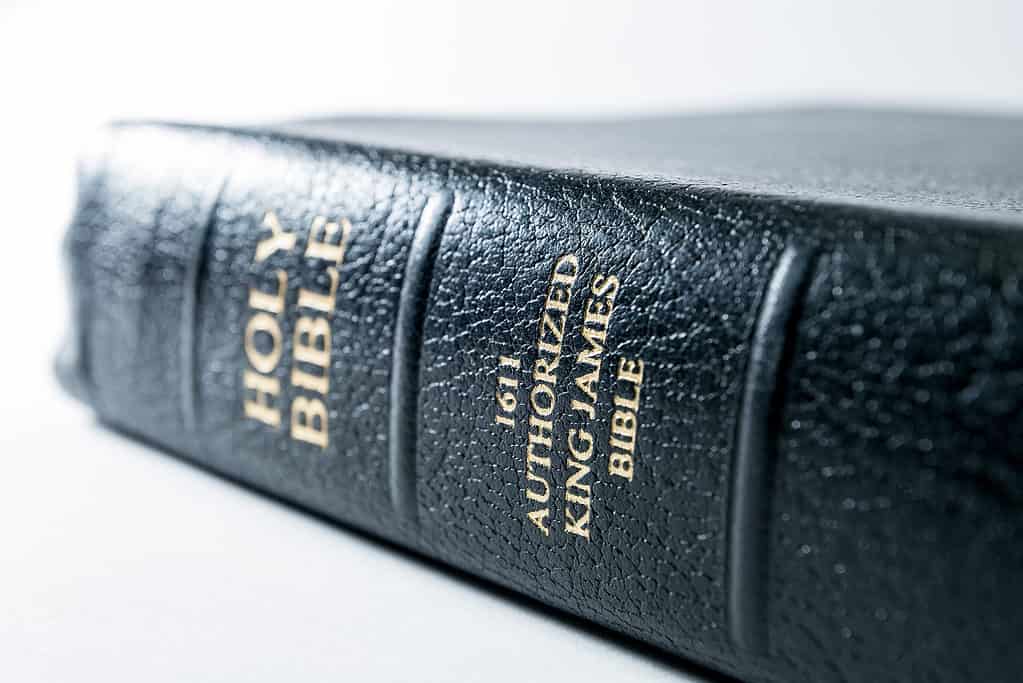
In Noah’s Ark, a dove released after the flood returns with an olive branch, marking the end of the flood.
©iStock.com/NathanMerrill
The mourning dove symbolizes hope, guidance, sacrifice, peace, and luck across cultures and religions. In Christianity, the dove is closely linked to the Holy Spirit. It’s often shown hovering over the Virgin Mary during the Annunciation, representing the divine presence and the conception of Jesus. And in the story of Noah’s Ark, a dove plays a key role. After the flood, Noah releases a dove, and when it returns with an olive branch, it marks the end of the flood and the beginning of a new chapter. This act symbolizes hope, renewal, and the promise of better days.
Archaeological findings from Jerusalem provide valuable insights into ancient religious practices. The analysis of bird remains unearthed in the region has confirmed that certain species, like pigeons and doves, were used in sacrificial rituals at the Temple. It’s likely doves were used as an alternate sacrifice when a lamb couldn’t be afforded.
In Japanese stories, doves take on a different role as messengers of war. This is quite different from their peaceful reputation in other cultures. In these stories, the image of a dove carrying a sword is used to represent the war’s conclusion.
Italian Folktale: The Dove

In an Italian folktale, a dove flying out of a pie breaks a curse on a prince, allowing true love to prevail.
©Phoo Chan/Shutterstock.com
“The Dove” is an Italian folktale that contains elements of magic, love, curses, and challenges. It teaches important lessons about kindness, gratitude, and the consequences of one’s actions. In the tale, a prince named Nardo Aniello didn’t act like a prince should. He treated a poor woman poorly and brought trouble upon himself.
Then one day he met a girl named Filadoro, and everything began to change. They instantly fell in love, and the prince was able to feel what it was like to care for another. But there was a big problem. Filadoro’s mother was an ogress, a kind of monster, who made the prince do impossible tasks. Each impossible task was harder than the last.
Thankfully, with the magical help of Filadoro, the prince manages to complete the tasks. However, things still didn’t go his way. Eventually, a curse placed on the prince made him forget his love for Filadoro. He couldn’t even remember what her face looked like. But don’t worry, in this tale, true love prevails, and in the strangest of ways.
While the prince was attending a feast, a dove flew out of a pie. This graceful bird broke the curse, instantly reminding the prince of Filadoro. He rushed to find her, told his mother about their promise, and they got married. They lived happily ever after, proving that even when things go wrong, there’s always a way to make them right. This short story also explores themes of morality, the power of love, and the importance of staying true to one’s promises.
Danish Fairytale: The White Dove
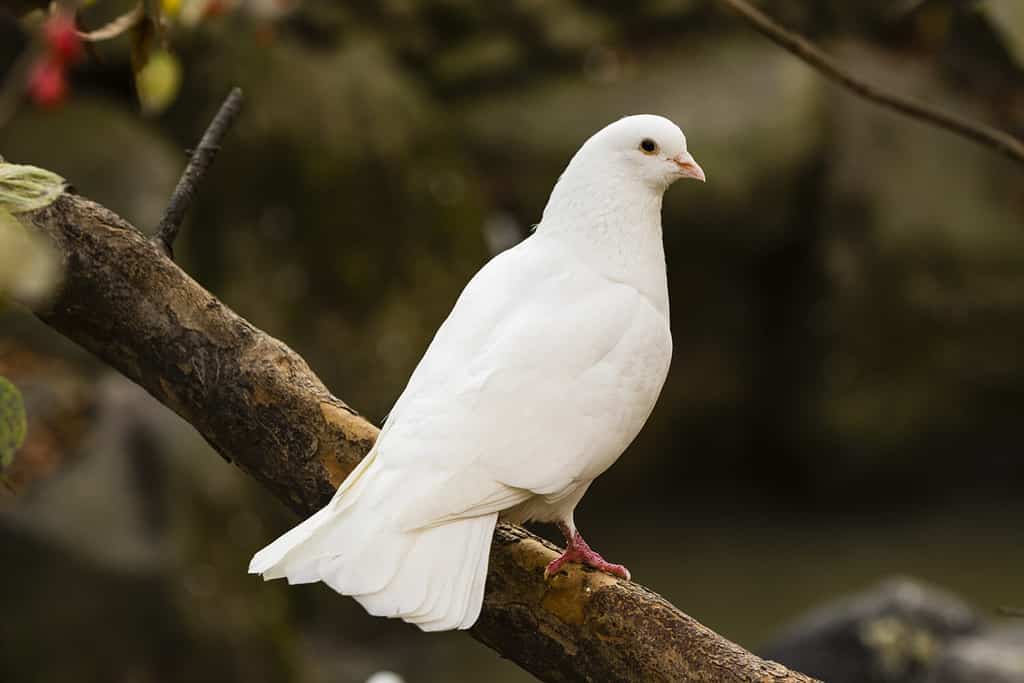
Mourning doves and white doves share symbolisms as seen in the Danish fairytale, “The White Dove”.
©Rene Baars/Shutterstock.com
There’s also a Danish fairytale that features a white dove. While white doves are different than mourning doves, they hold a lot of the same symbolism. The fairytale tells the story of two princes caught in a big storm at sea. An old woman appears in a boat offering to save them. But like all ominous characters who appear out of nowhere, she wanted something in return. The old woman made the men promise to give her their mother’s next born, and for this promise, she’d help them get home.
After returning home safely, the princes kept this secret for years, even after the birth of their little brother. Eventually, the sea witch came for the youngest brother and told him about the promise his older brothers made. She took him away to her home over the sea and gave the young prince the tough task of sorting a lot of feathers in a short time. Things seemed hopeless, that is until a magical dove (secretly a princess trapped by the witch) shows up.
The magical dove assists the prince, and just in time, they finish the task. The dove keeps helping until a kiss from the prince turns her back into a princess. But that’s not the end. After some surprises, the prince’s older brothers confess what happened at sea all those years ago. Feeling ashamed for what they did, they declare their little brother as king, ending our tale.
This Danish fairytale captures the essence of what doves are all about. The tale features multiple instances of transformation, like the magical dove turning into a princess. Or when the brothers change from being selfish to honest. These transformations highlight the potential for growth, change, and the possibility of making amends for past mistakes.
Native American Author Named Mourning Dove
Mourning Dove, a prominent writer, was the pen name of Christine Quintasket, who came from the Interior Salish tribe. The Interior Salish tribe encompasses various distinct First Nations, each group has its unique history, traditions, and cultural practices, contributing to the rich tapestry of Indigenous communities. Author Mourning Dove held a special place within her tribe and beyond, as she dedicated herself to preserving and sharing the stories of Northern Plateau peoples during the early 20th century. These stories carried immense weight due to her personal connection and deep understanding of the longstanding traditions that had been passed down through generations.
Not only did Mourning Dove collect and share these tribal stories, but she also went on to write a novel that drew from her own experiences and insights. Her most notable work, “Cogewea,” stands as the earliest known published novel authored by a Native American woman. This achievement is significant, as it marks a pioneering contribution to literature from a Native American female writer. Through her literary work, she provided invaluable glimpses into the cultures and traditions of tribal communities. However, her impact extends beyond her creative endeavors. Her political influence still captures the interest of academics and researchers today.
China Connection: Dove Staff
In China, there’s a strong connection between doves and living a long life. These graceful birds are seen as symbols of long life and fidelity, which means staying loyal and true. In some places, when someone in the community reached the impressive age of seventy, they were honored with a jade scepter. These scepters were usually about one foot long, and at one end there was a carving of a dove. This scepter was even given a nickname: the ‘dove staff.’ This was a way to show respect for older members of the community and to celebrate their wisdom and long journey through life.
Dove Royal Scepter: Rod of Equity and Mercy
During the Coronation of Charles II in 1661, a remarkable royal scepter made a significant appearance. This scepter was crafted by the skilled royal goldsmith, Robert Vyner, and featured a dove at its top. A golden cross supports the enameled dove with wings spread wide. Known as the ‘Rod of Equity and Mercy,’ this scepter symbolized the sovereign’s role in upholding justice and showing mercy.
The coronation of a new monarch was a moment rich with symbolism, emphasizing the noble and spiritual aspects of kingship. The dove-topped scepter represents the spiritual connection between the sovereign and the Holy Ghost. It embodied the monarch’s role in guiding their realm with both wisdom and a spiritual sense of duty.
Final Thoughts
Mourning doves carry a variety of symbols and meanings, like peace, love, protection, fertility, longevity, and transformation. These gentle birds have played significant roles in human history, conveying different messages across the world. Some Native American tribes considered them sacred, providing protection and a connection to the spirit world. While others thought the birds were symbols of foolishness or inexperience. These doves were even linked to the Aztec goddess Xochiquetzal and appeared in religious and folklore stories, leaving an impact on cultures globally. Their special courtship, lifelong partnerships, and devoted parenting highlight qualities of loyalty and devotion.
Additionally, mourning doves offer solace in times of grief, seen as messengers from departed loved ones, a reminder that we are not alone. Throughout history, their cooing has been seen as a sign of luck, communication, and preparation. Their calls prompt us to stay mindful of our emotions and surroundings.
Hearing the first mourning dove of the year from a high perch might mean good fortune. However, the interpretation is personal. The significance you find in mourning doves is what truly matters. When you see a mourning dove, it might make you feel calm, happy, or nostalgic. Whatever you feel, it’s a message meant just for you.
Thank you for reading! Have some feedback for us? Contact the AZ Animals editorial team.

